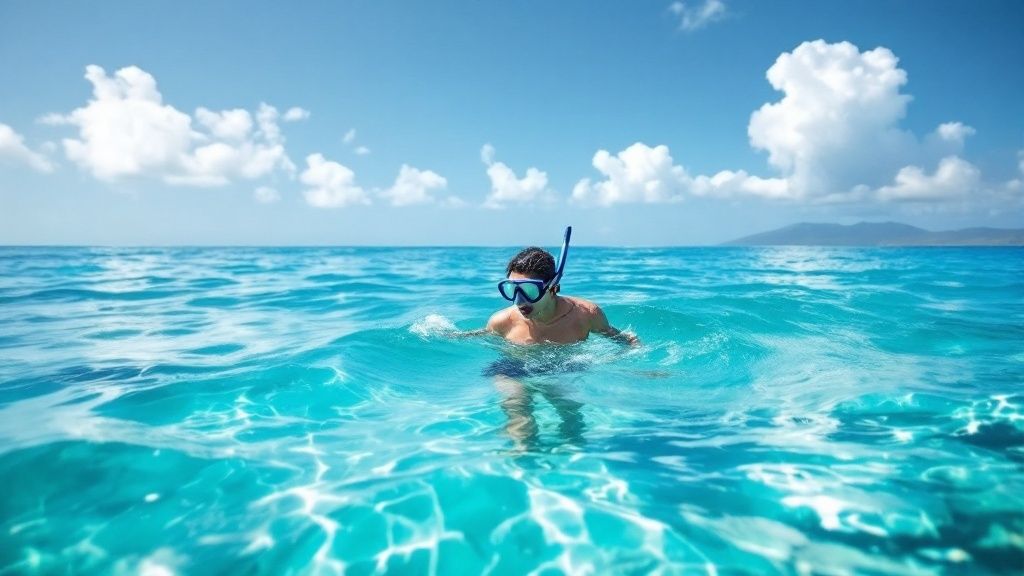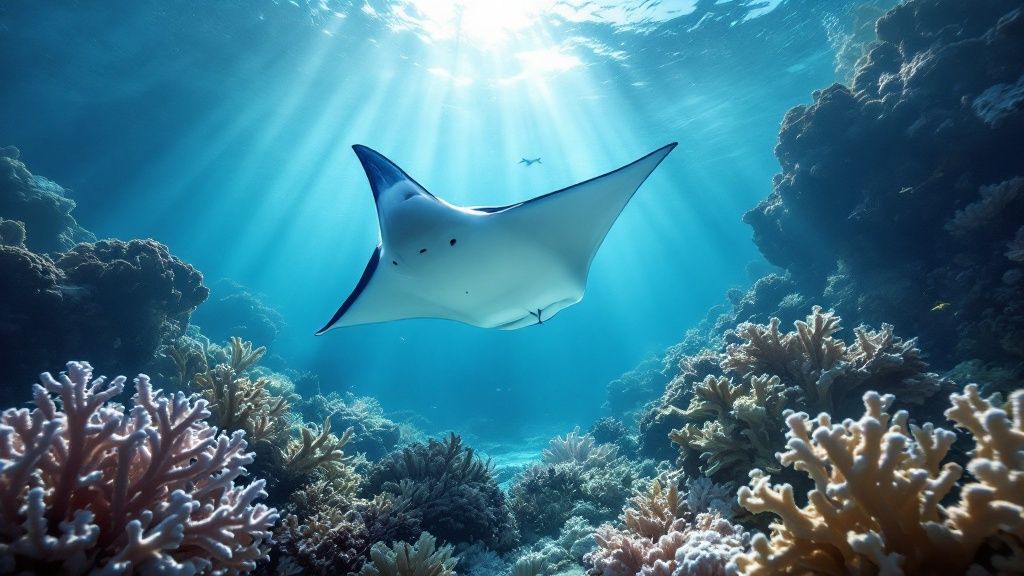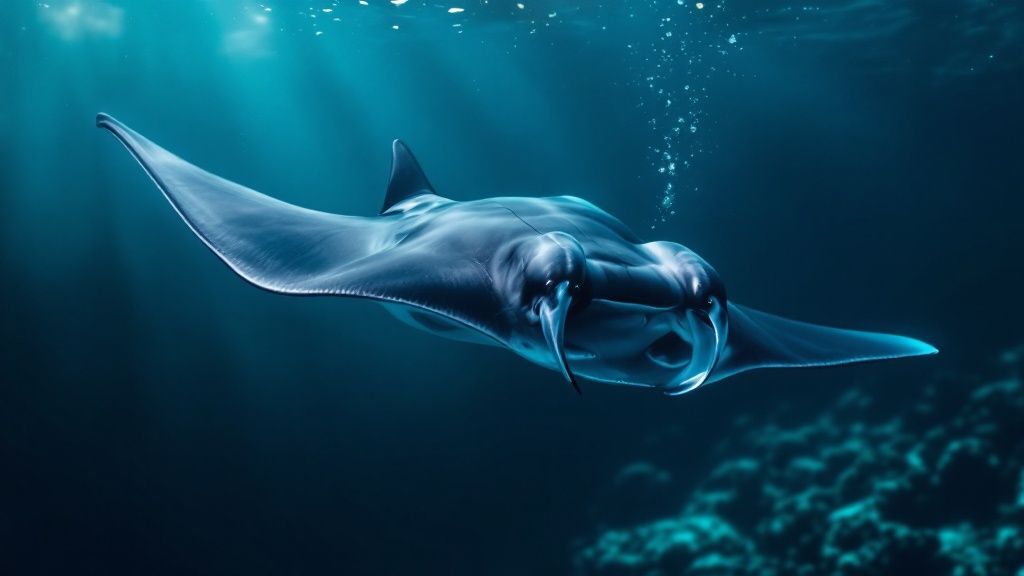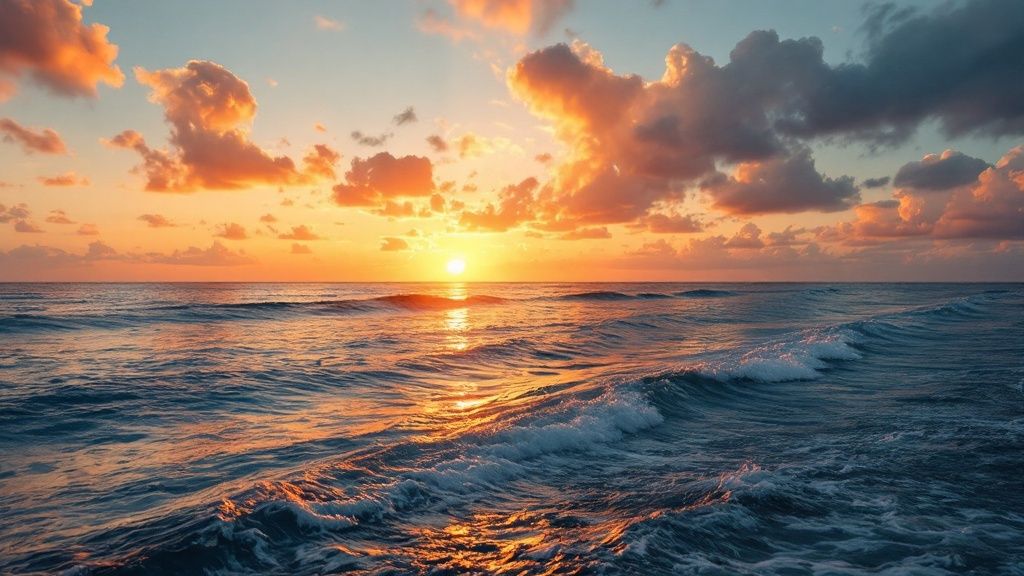Manta Ray Snorkel Kona: Top Tips & Must-See Spots
- Byron
- 16 hours ago
- 12 min read
Why Kona Offers World-Class Manta Ray Encounters
Kona, Hawaii, is more than just a beautiful island getaway; it's a world-renowned destination for manta ray encounters. What makes this location so special for these gentle giants? It's a unique blend of geological and ecological factors that create the perfect manta ray feeding ground.
The volcanic landscape of the Kona coastline plays a crucial role. Formed by ancient lava flows, the underwater terrain creates sheltered bays and coves. These areas offer calm waters ideal for plankton blooms, the main food source for manta rays. Nutrient-rich volcanic runoff further enhances these plankton populations, drawing manta rays in abundance. This means Kona provides a consistently rich and reliable food supply for these magnificent creatures.
The Kona Coastline: A Manta Ray Buffet
These plankton blooms are further amplified by a captivating natural phenomenon. At night, specialized lights used by tour operators attract even denser concentrations of plankton, creating a "plankton soup." This draws manta rays closer to the surface, allowing snorkelers to witness the awe-inspiring sight of these graceful giants feeding just inches below. Famous feeding spots like Manta Village and Manta Heaven are strategically positioned in areas known for these rich plankton concentrations and predictable manta ray activity.
Manta ray snorkeling off the Kona Coast is a globally recognized activity. This region is one of the few places where manta rays can be reliably observed year-round. From 2009 to 2014, underwater videographers documented individual manta rays at key locations, tracking their health and movements to analyze patterns and sighting frequency. This research revealed that Kona Coast manta rays display predictable behaviors and site fidelity, contributing to the high encounter rates that make Kona a premier destination for manta ray snorkeling and diving. For example, annual reports from 2011 to 2013 show consistent monthly sightings. This ongoing monitoring has increased conservation awareness and promoted tourism in the area. Find more detailed statistics here: Manta Ray Statistics You might also be interested in: Our Sitemap for More Articles
Hawaii's Volcanic History and Manta Ray Behavior
The relationship between Hawaii's volcanic history and the behavior of these ocean giants is truly remarkable. The volcanic formations provide ideal feeding environments and also influence water currents and nutrient distribution, impacting manta ray behavior. These gentle creatures return to the same feeding spots night after night, drawn by the promise of a plankton-rich meal.

These consistent sightings, along with the typically calm waters and clear visibility of Kona's coastline, make it a truly world-class location for manta ray encounters. Whether you're an experienced diver or a first-time snorkeler, witnessing these graceful creatures in their natural environment is an unforgettable experience.
Perfect Timing: When to Plan Your Manta Ray Adventure
Planning a manta ray snorkel in Kona, Hawaii, is more than just booking a tour; it's about choosing the right time to maximize your experience. Factors like the season, moon cycle, and even the time of day can significantly impact your encounter with these gentle giants.
Seasonal Considerations: Balancing Visibility and Crowds
Summer (April-October) typically offers the clearest waters and highest visibility due to calmer seas and less rain. This also coincides with peak manta ray activity, which means you'll likely encounter larger crowds. Conversely, winter (November-March) has fewer visitors, but potentially reduced visibility and rougher seas, although the manta rays are still active. Spring and fall offer a balance of decent visibility, manta ray activity, and manageable crowds.
To help visualize the seasonal differences, take a look at this table:
Seasonal Comparison for Manta Ray Snorkeling in Kona
Season | Water Conditions | Visibility | Crowd Levels | Manta Activity |
|---|---|---|---|---|
Summer (Apr-Oct) | Calm seas, less rain | Highest | High | Peak |
Fall (Sep-Nov) | Moderate conditions | Moderate | Moderate | Moderate |
Winter (Nov-Mar) | Rougher seas, potential rain | Reduced | Low | Active |
Spring (Mar-May) | Moderate conditions | Moderate | Moderate | Moderate |
As you can see, each season presents a unique set of conditions. Choosing the right one depends on your priorities, whether it's clear water, fewer crowds, or simply a balance of both.
The Lunar Cycle: Following the Plankton
The moon plays a surprising role in manta ray sightings. A full moon scatters plankton, making it harder for manta rays to feed near the surface, leading to potentially shorter or less frequent sightings. A new moon, however, creates darker conditions, concentrating plankton and drawing manta rays closer to the surface for better viewing.
Time of Day: Embracing the Night
Manta ray snorkel tours primarily operate at night. This is because the plankton they feed on is attracted to light. After-sunset tours offer the chance to see the Kona sunset before entering the magical underwater world of the manta rays. Later tours provide a fully immersive experience under the stars.
Weather Wisdom: Planning for Optimal Conditions
Even with the best season and moon phase, local weather can still affect visibility. Rainfall reduces water clarity, making it harder to see the manta rays. Always check the local weather forecast before your tour and consider rescheduling if heavy rain is predicted. Weather.com is a great resource for staying up-to-date.
Choosing the Best Time for You
Ultimately, the best time for your manta ray snorkel depends on your preferences. If crystal-clear visibility is essential, summer might be your best choice, despite the larger crowds. If you prefer a more intimate experience, winter might be ideal, but you might need to be flexible with weather conditions. For a balance of factors, the shoulder seasons of spring and fall are excellent options. Learn more about manta ray snorkeling in Kona. You can also check out our blog categories sitemap for additional information.
Insider's Guide to Kona's Premier Manta Ray Sites
Beyond the tourist brochures, Kona's manta ray sites offer diverse experiences. Drawing on insights from seasoned captains, let's explore the unique characteristics of these renowned locations.
Manta Village and Garden Eel Cove: Up Close and Personal
Manta Village, often called Manta Heaven, is a shallow, sandy area resembling an underwater amphitheater. This unique topography creates ideal feeding conditions, attracting manta rays in large numbers. This translates to exceptional viewing opportunities for snorkelers, but also means larger groups. The shallow depth can sometimes lead to accidental contact with the seabed if you aren't careful with your fin kicks.
Just a short distance away lies Garden Eel Cove. Known for its resident garden eels, this site also attracts manta rays due to its similarly plankton-rich waters. Its greater depth, however, can sometimes present more challenging conditions for less experienced snorkelers.
Beyond the Popular Spots: Intimate Encounters
For those seeking more intimate encounters, lesser-known sites offer unique advantages. Often accessed by smaller boats, these sites provide a more personalized experience with fewer snorkelers in the water.
Smaller group sizes create a more natural, less crowded encounter with the manta rays. This offers more opportunities to observe these gentle giants in a quieter, less disturbed environment.
Seasonal Variations and Site Selection
The time of year influences which site is most productive for manta ray sightings. During certain seasons, specific currents carry higher concentrations of plankton to certain areas. This affects which sites are favored by the manta rays. Our Sitemap for More Pages
Consulting with local experts and tour operators can help you choose the perfect spot based on the current season. This personalized approach can significantly improve your chances of a memorable encounter.
Key Factors to Consider When Choosing a Site:
Accessibility: How easy is it to reach the site by boat? Some sites are closer to shore, reducing travel time and minimizing potential seasickness.
Group Size: Do you prefer a larger group or a more intimate encounter? Smaller groups often provide more personal interaction with the manta rays and guides.
Underwater Features: What is the terrain like? Is it shallow and sandy, or deeper with more varied topography? This can impact visibility and the overall snorkeling experience.
Currents: Are the currents typically strong or mild? This is an important factor for less experienced snorkelers.
By carefully considering these factors and consulting with experienced local guides, you can choose the ideal manta ray snorkel site in Kona that aligns with your preferences and priorities. This ensures the most rewarding and memorable experience possible.

The Magic of Night: What Happens During Manta Ray Snorkels
A manta ray snorkel in Kona isn't just another ocean activity; it's a thoughtfully planned experience designed to maximize your enjoyment and protect these magnificent creatures. So, what awaits you on this magical nighttime adventure?
From Briefing to Breathtaking Encounters
Your journey starts with a safety briefing, covering essential procedures and responsible manta ray interaction. This emphasizes respecting these gentle giants and their environment. You'll then enter the water equipped with a wetsuit, snorkel gear, and a flotation device.
The "Plankton Soup" and Strategic Lighting
The core of the manta ray snorkel lies in the specialized lighting systems. These lights, strategically placed, attract plankton, the manta rays' primary food source. This creates a "plankton soup" near the surface. This concentration allows easy feeding for the manta rays and offers you an unparalleled view. Guides position snorkelers for optimal viewing while minimizing disturbance to the feeding manta rays. You’ll witness their graceful movements and feeding behaviors up close.
Addressing Common Concerns
Many first-time night snorkelers have anxieties about swimming in the dark. However, the experienced guides, flotation devices, and captivating manta rays usually ease these fears. Guides are trained to assist those prone to motion sickness or uncomfortable in open water. Holding onto a flotation device like a surfboard or boogie board with lights adds stability and security. Even less confident swimmers can relax and enjoy the spectacle.
Manta Ray Sightings and Tourism Impact
Manta ray encounters along the Kona Coast are remarkably frequent. Tour operators like Jack's Diving Locker report sightings roughly 85-90% of the time year-round. This high rate is exceptional compared to other wildlife tours. The underwater lights draw plankton, creating a feeding environment perfect for observation. With an estimated 80,000 annual participants on manta ray snorkeling tours in Kona, this activity is a significant part of Hawaii’s marine tourism. The consistent sightings contribute to Kona’s status as a leading destination for underwater wildlife tourism. For more information, check out the Jack's Diving Locker Manta Report.
Unforgettable Moments
As the manta rays glide through the illuminated water, sometimes inches from your mask, the experience becomes truly unforgettable. Their effortless movements, immense size, and gentle nature inspire wonder and respect. This encounter often fosters a deeper connection with the ocean. You might also be interested in Our Blog Post Sitemap.
Selecting the Ideal Manta Ray Tour For Your Experience
Choosing the right tour operator can truly make or break your manta ray snorkel Kona adventure. This guide will help you navigate the options and find the perfect tour to fit your needs.

Key Factors to Consider
Several important factors set exceptional manta ray tours apart. Think about these elements when making your decision.
Boat Design and Comfort: If you're prone to seasickness, boat size and stability are key. Smaller boats offer a more intimate experience, while larger vessels provide more stability. Look for easy water entry and exit points.
Equipment Quality: Comfortable, high-quality masks, snorkels, and wetsuits are essential. Some operators provide gear; others let you bring your own. Make sure provided equipment is well-maintained and fits correctly.
Guide Expertise and Passion: Knowledgeable guides enhance your tour with insights about manta ray behavior, marine life, and local ecology. A passionate guide can deepen your appreciation for these amazing creatures. Expertise also improves safety and adds value to the tour.
Group Size: Smaller groups offer personalized attention and more space to observe the manta rays without feeling crowded. Larger groups can be more lively but less intimate.
Sustainability Practices: Choose operators committed to responsible interactions with the manta rays and the environment. Look for certifications or practices that demonstrate their commitment to sustainability. Ask about procedures to minimize environmental impact.
Ocean Entry Techniques: Safe and easy entry and exit methods are crucial. Check if the operator utilizes techniques suitable for all experience levels, such as stable platforms for easy water entry.
Support Staff Ratio: A higher staff-to-guest ratio means more individualized attention and assistance, especially for first-time snorkelers or those nervous in the water. More staff also enhances safety.
To help you compare different tour operators, we've compiled a handy guide:
Manta Ray Tour Operator Comparison Guide
This table compares key aspects of top manta ray snorkel tour operators in Kona, helping you select the right provider based on important factors like group size, equipment quality, and conservation practices.
Tour Operator | Group Size | Equipment Quality | Conservation Practices | Price Range | Special Features |
|---|---|---|---|---|---|
(Example Operator 1) | 6-8 | High-quality rentals included | Active participant in reef cleanups | $150-$200 | Underwater photography assistance |
(Example Operator 2) | 10-15 | Basic rentals included, option to upgrade | Follows Leave No Trace principles | $120-$180 | Educational presentation on manta rays |
(Example Operator 3) | 4-6 | Premium rentals included | Partnered with local conservation organization | $200-$250 | Small group guarantee, extended snorkel time |
Please note: This is an example table and needs to be populated with real data from actual tour operators in Kona.
This table lets you quickly compare operators based on various factors, from group size and equipment quality to their commitment to conservation. Choosing the right operator ensures a more rewarding experience.
Decoding Pricing and Add-ons
Manta ray snorkel Kona tours vary in price. Premium costs can be justified by smaller groups, specialized equipment, or expert guides. However, not all add-ons are equal. Carefully examine what’s included and what costs extra. Some operators offer underwater photography packages or educational materials. Learn more in our sitemap.
Prioritizing Your Needs
Whether you’re focused on photography, scientific education, or a family-friendly trip, the ideal operator will cater to your specific needs. Some specialize in underwater photography, providing equipment and guidance. Others partner with marine biologists or conservation organizations for a deeper educational component. Families should seek child-friendly operators experienced with young snorkelers.
Making the Right Choice
By considering these factors and researching various operators, you can choose the manta ray tour that perfectly suits your preferences. Contact operators directly to ask questions and gain a better understanding of their offerings. This will ensure a truly unforgettable and enriching manta ray encounter.
Capturing the Magic: Manta Ray Photography Mastery
Transforming your Kona manta ray snorkel experience into lasting memories means capturing their magic through photography. This guide addresses the unique challenges of night water photography in Kona's manta ray environment.
Choosing the Right Equipment
Your equipment choice significantly impacts your results, from simple smartphone housings to professional setups.
Smartphone Housings: Affordable and convenient, these housings let you use your phone's camera underwater. Ensure a tight seal to prevent leaks.
Compact Cameras with Underwater Housings: These offer better image quality and control than smartphones, presenting a great mid-range option.
Professional Underwater Camera Systems: For serious photographers, these systems deliver superior image quality and advanced features.
Mastering Underwater Settings
Night snorkeling's unusual lighting requires specific camera settings.
High ISO: Increase your ISO to capture more light in the dark. Be aware of potential noise at very high ISO levels.
Wide Aperture: A wide aperture (low f-stop number) maximizes light intake and creates a shallow depth of field, blurring the background and emphasizing the manta rays.
Fast Shutter Speed: A fast shutter speed freezes the manta rays' movement, reducing motion blur.
Composition and Positioning
Clever positioning and composition are crucial for stunning manta ray images.
Shoot Upwards: Position yourself beneath the manta rays and shoot upwards. This captures their size and graceful movements against the illuminated surface.
Rule of Thirds: Use the rule of thirds to create visually appealing images. Imagine a tic-tac-toe grid on your frame and place key elements along these lines or intersections.
Capture the Details: Don't just focus on wide shots. Capture close-ups of their eyes, mouths, and unique spot patterns.
Lighting Techniques
Proper lighting balances visibility without disturbing the manta rays.
Utilize the Provided Lights: The lights used to attract plankton also illuminate the manta rays, creating excellent photo opportunities.
Avoid Flash Photography: Flash can startle the manta rays and disrupt their behavior. Rely on the existing light sources.
Post-Processing and Troubleshooting
Enhance your images while maintaining authenticity during post-processing.
Subtle Adjustments: Subtly adjust brightness, contrast, and sharpness to enhance the image without making it look unnatural. Use software like Adobe Photoshop or GIMP for these adjustments.
Correct White Balance: Underwater photos often have a blue or green tint. Correct the white balance to restore natural colors.
Reduce Backscatter: Backscatter shows up as small white specks. Reduce it in post-processing or by using a red filter on your camera lens.
Address Motion Blur: If your images have motion blur, try sharpening tools in post-processing or use a faster shutter speed next time.
By following these tips, you can capture breathtaking images of your Kona manta ray snorkel experience, preserving the memory of these gentle giants.
Swimming With Giants: Ethical Manta Ray Encounters
Swimming with manta rays in Kona is an unforgettable experience. But it's important to remember these gentle giants are vulnerable and deserve our respect. This section explores ethical manta ray encounters and how we can minimize our impact on these creatures and their ecosystem.
Understanding the Importance of Ethical Interactions
Manta rays aren't just a tourist attraction; they are essential members of the marine ecosystem. Their filter-feeding habits help maintain ocean health, and their presence enriches Kona's biodiversity. Protecting them isn't just about saving a species; it's about preserving the balance of the entire marine environment.
Science-Backed Guidelines for Respectful Encounters
Scientific research guides responsible manta ray interactions. Maintaining a safe distance is crucial. Getting too close can disrupt their behavior and stress these sensitive animals. Avoiding sudden movements and refraining from touching the manta rays is also essential. Their skin has a protective mucus layer, and touching disrupts this layer, making them vulnerable to diseases.

Choosing Responsible Tour Operators for Manta Ray Snorkel Kona
Responsible tour operators prioritize wildlife welfare over sensational interactions and educate guests about respectful behavior. Some limit group sizes to minimize disturbance, enforce strict no-touch policies, and partner with marine biologists to educate snorkelers. When choosing a manta ray snorkel Kona tour, seek operators committed to these ethical practices.
Tourism's Role in Conservation
Ethical tourism can fund crucial research and protection efforts. Many responsible tour operators contribute to manta ray research and conservation. This shows the positive impact sustainable tourism can have on wildlife. By participating in these tours, you directly support these important initiatives.
Contributing to Manta Ray Conservation
Beyond choosing ethical tours, you can contribute through citizen science. Some programs let you submit photos of encountered manta rays, helping researchers track individuals and monitor populations. These initiatives provide valuable data and offer a way to stay involved after your trip.
Making a Difference: From Entertainment to Conservation
By understanding ethical interactions, supporting responsible operators, and participating in conservation, your manta ray snorkel Kona adventure becomes more than just entertainment. It becomes a meaningful experience supporting these animals' future.
Ready for a magical manta ray experience while contributing to their conservation? Book your ethical manta ray night snorkel tour today! Manta Ray Night Snorkel Kona Hawaii Tours
Comments